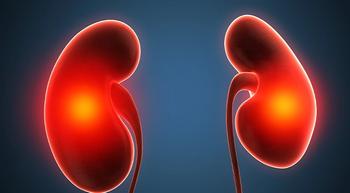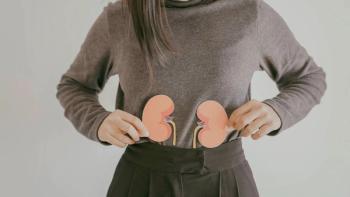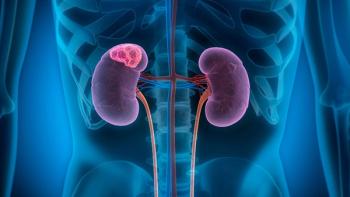
The Typical Prognosis of Aggressive Renal Cell Cancer
Transcript:
Karl J. D’Silva, M.D.: So Steve, moving towards the future, what is the status of your journey now? How are you feeling and what do you expect?
Steven Gallant: After September, once I got back into the gym and I started exercising, I’ve really pushed hard. After we spoke, I told you I was going to push hard and you said there’s no reason why you can’t. My blood, every time I went to you, you told me how good my blood tests were. You said everything was perfect. So I’d go to the gym, I did an hour of yoga every day, well not every day. Every time I went, I’d go five days a week, and then I’d do an hour or two of working out, depending on what I was working out that day. Then I’d do aerobics. I got to where I was about 222 pounds, so I put on 30 pounds of muscle mass. My waistline kept getting smaller which was interesting. I didn’t think it could get any smaller than it was in September. Matter of fact, the suit I have on is a suit I bought in the ’80s. So that was pretty good. I put 30 pounds back on, and in February I called you up.
Actually, when I saw you, I told you I went back to work. I started work in February, back in the building trades, which is pretty strenuous. It’s on my feet eight hours a day, constantly physical. I don’t hang the sheetrock like I used to, that I love to do, but I’m doing all other facets of the building trade. We do commercial buildings. We build a lot of buildings like this. I worked February right up until last week, and we just finished three big jobs. I’ll tell you what, a couple days ago, it got beautiful out, and today and yesterday I felt as good as I’ve felt in years.
Karl J. D’Silva, M.D.: That’s nice.
Steven Gallant: I don’t even feel like there’s any cancer in me. The only issue I have, of course, is with the inferior vena cava, which was damaged in the operation, which is separate. But other than that, I feel amazing, and the last couple of days I went to the beach. I went north up into New Hampshire and went up to the beaches. It was nice. It’s good to be back.
Karl J. D’Silva, M.D.: Yes, because the temperature went up to 80 [degrees].
Steven Gallant: Yes. I used to hike. I’ve been in almost every national park in the country. I’ve been in every state twice, and I’ve done a lot of the big hikes, and I’ve been out in the woods a lot. It was very important to me to be able to get back out there. I’ve actually done some small hikes, but the endurance is something I need to work on, absolutely.
Karl J. D’Silva, M.D.: Steve’s journey doesn’t reflect the standard patient experience. I think you definitely had a high-risk disease, but because of the novel agents like cabozantinib or any of the agents, we do not know what is coming in the future. But basically, with the modern therapeutics, we are able to understand some of the molecular markers of cancer, especially understanding the angiogenesis pathway, the mTOR [mammalian target of rapamycin] pathway, as well as the altered immune mechanism. I do think that we definitely have a bright future, and you have done so beautifully with the past one year, four months with this drug itself. Look at you, you’re looking great.
Steven Gallant: Thank you.
Karl J. D’Silva, M.D.: I do think that looking at your success, I have used this drug on quite a number of patients, and I’ve seen very good results. I think you are the poster child for me.
Steven Gallant: Does everybody else have, are they performing like I am?
Karl J. D’Silva, M.D.: They did not have such an aggressive disease, so they are doing well, yes. Like you were the first one, and they’ve just started some of them. Yes, they are doing very well, actually.
Steven Gallant: Good.
Karl J. D’Silva, M.D.: I’m very happy, actually. And you motivated me to make sure that other patients are also doing better.
Steven Gallant: Ten years ago, how often did something like this happen, somebody get cured like this? I never asked you this.
Karl J. D’Silva, M.D.: No, actually, I won’t say it’s a cure but control of the disease.
Steven Gallant: Right.
Karl J. D’Silva, M.D.: So basically, 10 years ago, there was only one drug, and it has been there for such a long time. But a lot of patients used to progress, and we were able to go back to find out why did they progress. And looking at newer drugs.
Steven Gallant: Did they progress as quickly as I did?
Karl J. D’Silva, M.D.: Yes. At that point, if you had gotten like nine months, 11 months [of response], you had a winner. But you did one of the best, actually, more than a year. So definitely cabozantinib was able to target some of the resistant mechanisms, which you see with other tyrosine kinase inhibitor like Sutent, where you could see activation of the AXL, MET, which cabozantinib was able to block. That’s why we were able to get more than one year of response.
Steven Gallant: If you think about it, it was six months. I mean, my best results were March to September.
Karl J. D’Silva, M.D.: Yes. But you had such an aggressive disease, widespread, you’re melting that tumor. That’s important for us, and then you want to stabilize it. So that’s what we were trying to do for you.
Steven Gallant: And now it’s stabilized.
Karl J. D’Silva, M.D.: Now it is stabilized. The last CT [computed tomography] scan….
Steven Gallant: I’m a miracle man. I have a funny side note. My boss, when I went back to work in February, he introduced me to everybody as stage 4. He’d say, “Hey, John, this is stage 4.” And I’d go, no, you can’t call me that anymore, I’m miracle man. Now there’s all these people who don’t know my real name, they call me stage 4. That’s the truth, too.
Karl J. D’Silva, M.D.: So we always ask this question, how do patients need to be proactive in finding out information? I’m sure you must be looking to the internet and joining some kidney awareness group. Have you done that to find out more information?
Steven Gallant: No groups, but my whole life I read a lot; I mean I read a lot. When I was in college as a youngster back in the ’70s, I took genetics and human anatomy, physiology, and then I went back to college, and I took them again. I’ve taken a lot of psychology courses, and I’ve read a lot of books. I actually read a book in the ’80s called “Miracle Cures,” and it was people who were cured miraculously. I learned way back then about the power of thinking. I was like prepping myself way back then for now, and having the internet now, I mean who would have thought 30 years ago that we’d have the power we do at our fingertips? Any time when we spoke or any time I’d leave the office, I would go home and I would Google stuff. I was constantly online reading. My sister, every time I’d get back home, my sister would be on the computer and she’d tell me what would happen in our meetings because it was right at instant fingertips. I would go and I would Google stuff as we saw stuff that we weren’t sure about. So just having the internet at somebody’s fingertips, do yourself a favor, read everything, read as much as you can, absolutely. It’s important.
Karl J. D’Silva, M.D.: This is such an impressive story. Definitely, I feel so moved actually listening to you. I’ve been your doctor treating you, so that’s good. What would be your take-home message, your closing thought to patients, caregivers about your disease?
Steven Gallant: I’ve covered a lot of it already. My takeaway is to never be a victim. From the minute you are diagnosed with anything, it doesn’t matter what it is, be positive, be proactive, work hard. There were days when I couldn’t eat or drink, and I used some mental tricks. The easiest one for me was all I had to do was picture my son in my mind. I would say how is this going to help my relationship with my son, and that would make me drink that water because I knew how important water was to survival. And there were days when I didn’t want to drink water. And eating, there’s no flavor to food when you’re sick, and I would force myself to eat, and I would use every trick in the book to just do everything that’s necessary. Listen to the doctors. And seriously, read everything about whatever it is you have, especially cancer. There’s a lot of information.
Karl J. D’Silva, M.D.: Yes. I’ve seen the health care providers and the team. They work tirelessly to make sure to help patients in this stressful environment. And I think as long as we have the participation of patients and their families in our decision-making process, we can really move forward into getting better treatment options for our patients with kidney cancer.
Thank you so much for joining Steven and me with CURE Expert Connections® in the diagnosis and treatment of renal cell carcinoma.
Transcript Edited for Clarity



